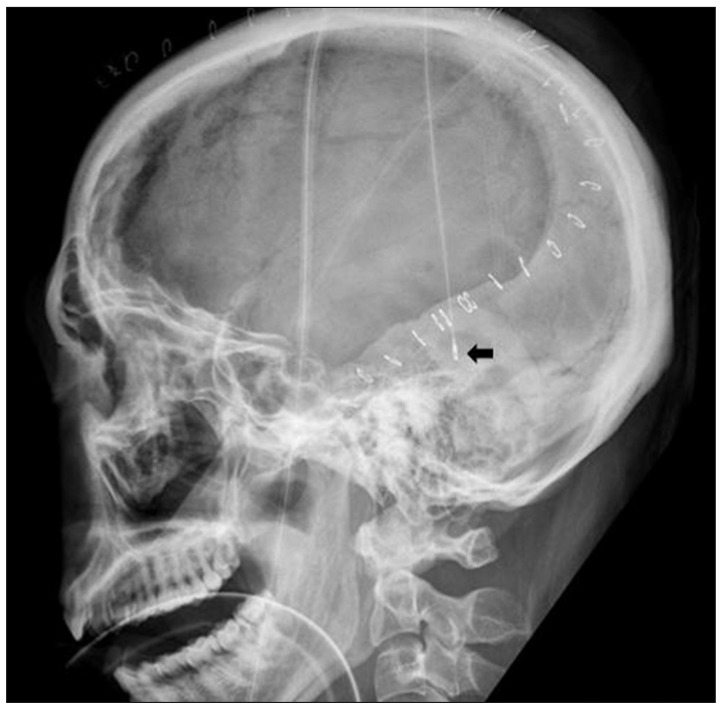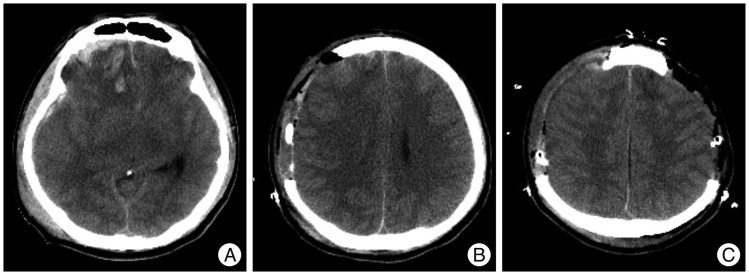J Korean Neurosurg Soc.
2014 Jan;55(1):26-31. 10.3340/jkns.2014.55.1.26.
Significance of Intracranial Pressure Monitoring after Early Decompressive Craniectomy in Patients with Severe Traumatic Brain Injury
- Affiliations
-
- 1Department of Neurosurgery, Eulji University School of Medicine, Eulji General Hospital, Seoul, Korea.
- 2Department of Neurosurgery, St. Vincent's Hospital, College of Medicine, The Catholic University of Korea, Suwon, Korea.
- 3Department of Neurosurgery, Seoul St. Mary's Hospital, College of Medicine, The Catholic University of Korea, Seoul, Korea. sbc@catholic.ac.kr
- KMID: 2191036
- DOI: http://doi.org/10.3340/jkns.2014.55.1.26
Abstract
OBJECTIVE
Early decompressive craniectomy (DC) has been used as the first stage treatment to prevent secondary injuries in cases of severe traumatic brain injury (TBI). Postoperative management is the major factor that influences outcome. The aim of this study is to investigate the effect of postoperative management, using intracranial pressure (ICP) monitoring and including consecutive DC on the other side, on the two-week mortality in severe TBI patients treated with early DC.
METHODS
Seventy-eight patients with severe TBI [Glasgow Coma Scale (GCS) score <9] underwent early DC were retrospectively investigated. Among 78 patients with early DC, 53 patients were managed by conventional medical treatments and the other, 25 patients were treated under the guidance of ICP monitoring, placed during early DC. In the ICP monitoring group, consecutive DC on the other side were performed on 11 patients due to a high ICP of greater than 30 mm Hg and failure to respond to any other medical treatments.
RESULTS
The two-week mortality rate was significantly different between two groups [50.9% (27 patients) and 24% (6 patients), respectively, p=0.025]. After adjusting for confounding factors, including sex, low GCS score, and pupillary abnormalities, ICP monitoring was associated with a 78% lower likelihood of 2-week mortality (p=0.021).
CONCLUSION
ICP monitoring in conjunction with postoperative treatment, after early DC, is associated with a significantly reduced risk of death.
MeSH Terms
Figure
Cited by 1 articles
-
Circadian Biorhythmicity in Normal Pressure Hydrocephalus - A Case Series Report
Leszek Herbowski
J Korean Neurosurg Soc. 2022;65(1):151-160. doi: 10.3340/jkns.2021.0088.
Reference
-
1. Aarabi B, Hesdorffer DC, Ahn ES, Aresco C, Scalea TM, Eisenberg HM. Outcome following decompressive craniectomy for malignant swelling due to severe head injury. J Neurosurg. 2006; 104:469–479. PMID: 16619648.
Article2. Akyuz M, Ucar T, Acikbas C, Kazan S, Yilmaz M, Tuncer R. Effect of early bilateral decompressive craniectomy on outcome for severe traumatic brain injury. Turk Neurosurg. 2010; 20:382–389. PMID: 20669113.
Article3. Bao YH, Liang YM, Gao GY, Pan YH, Luo QZ, Jiang JY. Bilateral decompressive craniectomy for patients with malignant diffuse brain swelling after severe traumatic brain injury : a 37-case study. J Neurotrauma. 2010; 27:341–347. PMID: 19715392.
Article4. Brain Trauma Foundation. American Association of Neurological Surgeons. Congress of Neurological Surgeons. Joint Section on Neurotrauma and Critical Care, AANS/CNS. Bratton SL, et al. Guidelines for the management of severe traumatic brain injury. I. Blood pressure and oxygenation. J Neurotrauma. 2007; 24(Suppl 1):S7–S13. PMID: 17511549.5. Cremer OL, Moons KG, van Dijk GW, van Balen P, Kalkman CJ. Prognosis following severe head injury : development and validation of a model for prediction of death, disability, and functional recovery. J Trauma. 2006; 61:1484–1491. PMID: 16983303.
Article6. Fakhry SM, Trask AL, Waller MA, Watts DD. Management of brain-injured patients by an evidence-based medicine protocol improves outcomes and decreases hospital charges. J Trauma. 2004; 56:492–499. discussion 499-500. PMID: 15128118.
Article7. Farahvar A, Gerber LM, Chiu YL, Carney N, Härtl R, Ghajar J. Increased mortality in patients with severe traumatic brain injury treated without intracranial pressure monitoring. J Neurosurg. 2012; 117:729–734. PMID: 22900846.
Article8. Farahvar A, Gerber LM, Chiu YL, Härtl R, Froelich M, Carney N. Response to intracranial hypertension treatment as a predictor of death in patients with severe traumatic brain injury. J Neurosurg. 2011; 114:1471–1478. PMID: 21214327.
Article9. Faul M, Wald MM, Rutland-Brown W, Sullivent EE, Sattin RW. Using a cost-benefit analysis to estimate outcomes of a clinical treatment guideline : testing the Brain Trauma Foundation guidelines for the treatment of severe traumatic brain injury. J Trauma. 2007; 63:1271–1278. PMID: 18212649.
Article10. Gerl A, Tavan S. [Bilateral craniectomy in the treatment of severe traumatic brain edema]. Zentralbl Neurochir. 1980; 41:125–138. PMID: 7435005.11. Guerra WK, Gaab MR, Dietz H, Mueller JU, Piek J, Fritsch MJ. Surgical decompression for traumatic brain swelling : indications and results. J Neurosurg. 1999; 90:187–196. PMID: 9950487.
Article12. Haselsberger K, Pucher R, Auer LM. Prognosis after acute subdural or epidural haemorrhage. Acta Neurochir (Wien). 1988; 90:111–116. PMID: 3354356.
Article13. Kjellberg RN, Prieto A Jr. Bifrontal decompressive craniotomy for massive cerebral edema. J Neurosurg. 1971; 34:488–493. PMID: 5554353.
Article14. Langlois JA, Kegler SR, Butler JA, Gotsch KE, Johnson RL, Reichard AA, et al. Traumatic brain injury-related hospital discharges. Results from a 14-state surveillance system, 1997. MMWR Surveill Summ. 2003; 52:1–20. PMID: 12836629.15. Langlois JA, Rutland-Brown W, Wald MM. The epidemiology and impact of traumatic brain injury : a brief overview. J Head Trauma Rehabil. 2006; 21:375–378. PMID: 16983222.16. Maas AI, Dearden M, Teasdale GM, Braakman R, Cohadon F, Iannotti F, et al. European Brain Injury Consortium. EBIC-guidelines for management of severe head injury in adults. Acta Neurochir (Wien). 1997; 139:286–294. PMID: 9202767.
Article17. Marshall LF. Head injury : recent past, present, and future. Neurosurgery. 2000; 47:546–561. PMID: 10981741.18. Marshall LF, Marshall SB, Klauber MR, Van Berkum Clark M, Eisenberg H, Jane JA, et al. The diagnosis of head injury requires a classification based on computed axial tomography. J Neurotrauma. 1992; 9(Suppl 1):S287–S292. PMID: 1588618.19. McKinley BA, Parmley CL, Tonneson AS. Standardized management of intracranial pressure : a preliminary clinical trial. J Trauma. 1999; 46:271–279. PMID: 10029033.20. Miyazaki Y, Hirai H, Hachisu Y, Takada I. [Bifrontal external decompression for traumatic brain edema]. Shujutsu. 1966; 20:845–852. PMID: 5978607.
Article21. Morgalla MH, Krasznai L, Buchholz R, Bitzer M, Deusch H, Walz GU, et al. Repeated decompressive craniectomy after head injury in children : two successful cases as result of improved neuromonitoring. Surg Neurol. 1995; 43:583–589. discussion 589-590. PMID: 7482239.22. Münch E, Horn P, Schürer L, Piepgras A, Paul T, Schmiedek P. Management of severe traumatic brain injury by decompressive craniectomy. Neurosurgery. 2000; 47:315–322. discussion 322-323. PMID: 10942004.
Article23. Palmer S, Bader MK, Qureshi A, Palmer J, Shaver T, Borzatta M, et al. The impact on outcomes in a community hospital setting of using the AANS traumatic brain injury guidelines. Americans Associations for Neurologic Surgeons. J Trauma. 2001; 50:657–664. PMID: 11303160.
Article24. Plesnila N. Decompression craniectomy after traumatic brain injury : recent experimental results. Prog Brain Res. 2007; 161:393–400. PMID: 17618993.25. Polin RS, Shaffrey ME, Bogaev CA, Tisdale N, Germanson T, Bocchicchio B, et al. Decompressive bifrontal craniectomy in the treatment of severe refractory posttraumatic cerebral edema. Neurosurgery. 1997; 41:84–92. discussion 92-94. PMID: 9218299.
Article26. Roberts I, Yates D, Sandercock P, Farrell B, Wasserberg J, Lomas G, et al. Effect of intravenous corticosteroids on death within 14 days in 10008 adults with clinically significant head injury (MRC CRASH trial) : randomised placebo-controlled trial. Lancet. 2004; 364:1321–1328. PMID: 15474134.27. Roberts SR, Hamedani B. Benefits and methods of achieving strict glycemic control in the ICU. Crit Care Nurs Clin North Am. 2004; 16:537–545. PMID: 15571942.
Article28. Sahuquillo J, Arikan F. Decompressive craniectomy for the treatment of refractory high intracranial pressure in traumatic brain injury. Cochrane Database Syst Rev. 2006; (1):CD003983. PMID: 16437469.
Article29. Servadei F, Compagnone C, Sahuquillo J. The role of surgery in traumatic brain injury. Curr Opin Crit Care. 2007; 13:163–168. PMID: 17327737.
Article30. Stein SC, Georgoff P, Meghan S, Mirza KL, El Falaky OM. Relationship of aggressive monitoring and treatment to improved outcomes in severe traumatic brain injury. J Neurosurg. 2010; 112:1105–1112. PMID: 19747054.
Article31. Unterberg AW, Stover J, Kress B, Kiening KL. Edema and brain trauma. Neuroscience. 2004; 129:1021–1029. PMID: 15561417.
Article32. van Baalen B, Odding E, Maas AI, Ribbers GM, Bergen MP, Stam HJ. Traumatic brain injury : classification of initial severity and determination of functional outcome. Disabil Rehabil. 2003; 25:9–18. PMID: 12554388.
Article33. Wolfla CE, Luerssen TG, Bowman RM. Regional brain tissue pressure gradients created by expanding extradural temporal mass lesion. J Neurosurg. 1997; 86:505–510. PMID: 9046308.
Article34. Wolfla CE, Luerssen TG, Bowman RM, Putty TK. Brain tissue pressure gradients created by expanding frontal epidural mass lesion. J Neurosurg. 1996; 84:642–647. PMID: 8613857.
Article35. Yamakami I, Yamaura A. Effects of decompressive craniectomy on regional cerebral blood flow in severe head trauma patients. Neurol Med Chir (Tokyo). 1993; 33:616–620. PMID: 7505400.
Article
- Full Text Links
- Actions
-
Cited
- CITED
-
- Close
- Share
- Similar articles
-
- Outcomes of Ultra-Early Decompressive Craniectomy after Severe Traumatic Brain Injury-Treatment Outcomes after Severe TBI
- Paradoxical Herniation after Decompressive Craniectomy for Acute Subdural Hematoma
- Effects of Decompressive Craniectomy for the Management of Patients with Refractory Intracranial Hypertension
- The relationship between the serum lactate level and in-hospital mortality after decompressive craniectomy in traumatic brain Injury
- Early Preventive Decompressive Craniectomy in Patients with Severe Traumatic Brain Injury



